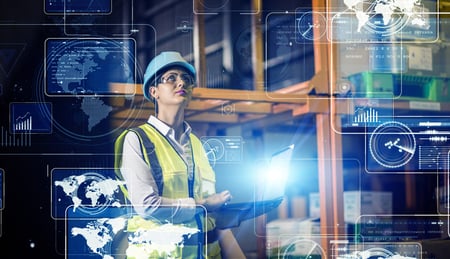 What is IOT and IIOT and Why Does It Matter to Your Business?
What is IOT and IIOT and Why Does It Matter to Your Business?
What do we mean when we refer to IOT (Internet of Things), IIOT (Industrial Internet of Things), or telematics? All three terms refer essentially to the same idea: any device that can communicate to the cloud, providing information that leads to meaningful action.
How IOT Should Work
If you are a manufacturer or distributor, IOT’s first job should be to provide you with actionable data on your most strategic business processes and assets. If you are a manufacturer, that means your manufacturing/production equipment. If a distributor, then it is your inventory and material handling processes. For soup companies, that means sensors on soup manufacturing equipment; for beer companies, sensors on beer manufacturing equipment. The job of IOT is simple: to aggregate data, provide insights and to deliver concrete actions for your team to take to improve operations.
After you nail IoT for strategic assets like manufacturing equipment, then companies can set their sights on their material handling equipment. It is a critical part of operations and a top 3 cost at a high velocity warehouse.
What to Implement for Material Handling & Forklift Power
A full implementation of a forklift telematics solution may work well for the highest velocity facilities of Fortune 500 companies with constantly changing operations, but for many customers, it can be overkill.
Here’s what we believe you should keep in mind as you look at systems:
-
Ensure your system is easy to manage and use
-
You shouldn’t be laboring to decipher the data from your telematics in order to gain insights.
-
Don’t purchase a telematics offering that will require much of your time to initially configure or tweak further down the line. If there is a significant management component after setup, steer clear—except, perhaps, if you run one of the largest facilities in the country.
-
The system you buy should give you data-driven actions and insight, not a lot of charts and data that your team must swim through constantly.
-
-
Focus on the most valuable data
-
We believe you should start with the simplest telematics solutions and work up from there. Perhaps because we are a forklift power vendor, we actually think the battery/charger side is the easiest and cheapest way to get started.
-
An upcoming blog will have a more detailed breakdown of how to understand what your facility needs, so stay tuned!
In the meantime, here are three “dirty little secrets” about IOT you may not know.
IOT’s Three Dirty Little Secrets:
1. You may not even need IOT when it comes to material handling equipment. The reality is that this decision depends upon your strategic needs. As stated before, you probably need IOT on your production/manufacturing equipment first, followed by your forklifts. The bigger your facility, the higher the velocity, the more shifts you run and the more equipment you have, the more likely it is that IOT is going to help you. But if your facility is smaller and/or lower velocity, IOT may not have a reasonable ROI. A second option—start with a forklift power offering with sensor data so you have good visibility to usage and ensure uptime over the full asset life you expect.
2. Use a closed, independent wi-fi system—and don’t manage it yourself. IOT can create security issues, a cost issues, and a data uptime issues. If you use IOT, make sure your telematics partner is also your maintenance partner--or that your maintenance partner can take ownership for the IoT assets and connectivity for you. Avoid using modems and your own network; let your vendor deploy and manage both your wi-fi system and the individual battery/forklift sensors. Ideally, your on-site forklift or power partner is the one deploying and managing the solution—not a telematics company. Your local technician really needs to be in charge of keeping those assets live, not some engineer in the middle of Kansas that works for the telematics vendor. In short, the safest, most secure, most efficient choice is to utilize a closed, independent wi-fi system.
3. Telematics data is primarily useful for two periods of time, and companies that don’t outsource almost always miss out on the second one.
In critical power, these two important periods occur:
-
First 3-6 months of implementation – Most companies pay attention to this timeframe, because new data provided by telematics is very revealing. This ramping-up period typically exposes or clarifies issues that need to be addressed immediately. These problems tend to be the same main issues across companies and industries: operator behavior or compliance problems; changes required in charging infrastructures, technologies, or the business process at large; or simply lack of data that helps to match the correct truck to the correct operator to the correct battery.
-
Years 3-5 – This valuable period of time in telematics is often overlooked. During this timeframe, telematics can provide a company with its most valuable data about aging assets. For example, at this stage, batteries are aging and companies typically see meaningful turnover among drivers. For these reasons and more, years 3-5 are the years where telematics can provide the most valuable data. A company’s vendor should use it to improve charge profiles for lead acid and battery software (if it is a lithium battery). Unfortunately, by year 3, most telematic systems have long since been abandoned or forgotten. That’s often because the person who bought and ran telematics has changed jobs or been promoted, leaving behind no one with the knowledge base to replace sensors or interpret data.
So, precisely when telematics could prove to be an exceptionally useful investment, the system has been largely abandoned. Time after time, companies lose access to data just when it has become crucial to them and an entire expensive system is essentially rendered useless.
This is why outsourcing is so crucial when it comes to IOT or telematics. Outsourcing means someone is always maintaining data and telematics equipment. Turnover, equipment degradation, loss of interest, seasonal hires and fires: in terms of your data, none of it matters. Outsourcing IOT means you never lose access to the information you need just as it becomes of strategic importance. More importantly, push your vendor partner to take action on the data, rather than you and your team—that’s what they are there to do, after all!
The truth is, you may not even need IOT/forklift telematics data. But if you do, we recommend you outsource it. That’ll ensure your vendor partner is the one required to keep the sensors and wi-fi system live and running, as well as required to monitor and take action on the insights the data delivers. This is how Concentric’s engineered systems works—we can provide reports/analytics to the customer, but we view it as our responsibility to take action at a maintenance and power system tweaking standpoint to meet our power contract commitments.


 Ryan Lynch
Ryan Lynch
